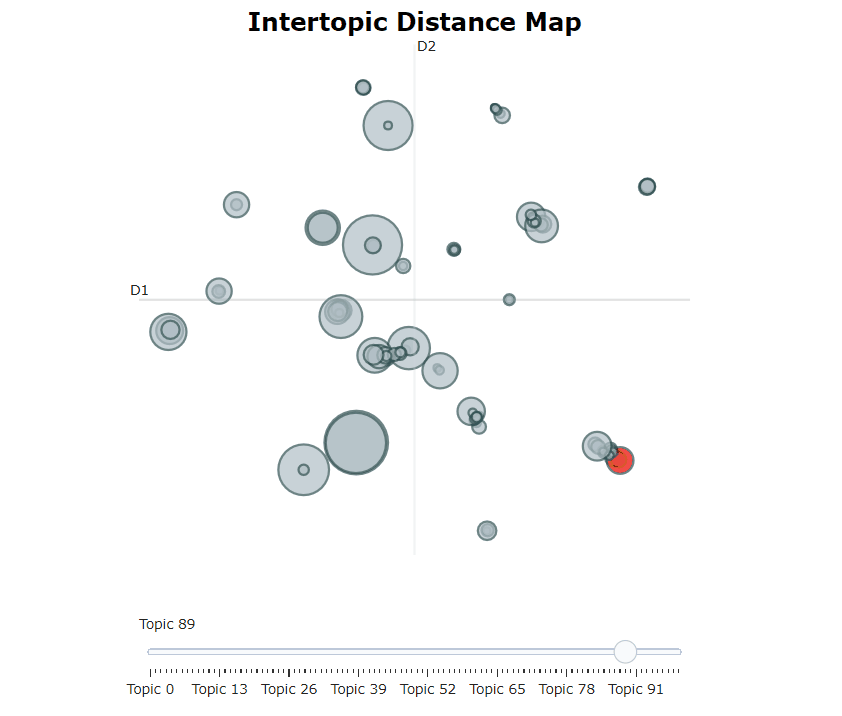BERTopic
BERTopic is a topic modeling technique that leverages
Corresponding medium post can be found here and here.
Installation
Installation can be done using a local installation as the custom package is not published.
- Clone the topic modelling repo locally and move the csv filesdownloaded from PhantomBuster in the folder: topic-modeling/data/input Note: It is recommended to have a new Pyhton environment and then you can install the dependencies accordingly.
- Now follow these steps to install a local package(Custom BERTopic):
git clone https://github.com/atoti/BERTopic.git
cd ../gitclonedirectory/BERTopic
pip install -e .
Getting Started
For an in-depth overview of the features of BERTopic
you can check the full documentation here or you can follow along
with the Google Colab notebook here.
Quick Start
We start by extracting topics from the well-known 20 newsgroups dataset which is comprised of english documents:
from bertopic import BERTopic
from sklearn.datasets import fetch_20newsgroups
docs = fetch_20newsgroups(subset='all', remove=('headers', 'footers', 'quotes'))['data']
topic_model = BERTopic(
similarity_threshold_merging=0.5, # provide here you desired topics merging similarity threshold (between 0 and 1)
topic_words_diversity=0.5, # provide here you desired keywords diversity ratio
stop_words = STOP_WORDS, # STOP_WORDS is your custom stop words list
replace_dic = REPLACE, # REPLACE is your custom dictionary of words replacement
)
topics, _ = topic_model.fit_transform(docs)After generating topics and their probabilities, we can access the frequent topics that were generated:
>>> topic_model.get_topic_freq().head()
Topic Count
-1 7288
49 3992
30 701
27 684
11 568-1 refers to all outliers and should typically be ignored. Next, let's take a look at the most
frequent topic that was generated, topic 49:
>>> topic_model.get_topic(49)
[('windows', 0.006152228076250982),
('drive', 0.004982897610645755),
('dos', 0.004845038866360651),
('file', 0.004140142872194834),
('disk', 0.004131678774810884),
('mac', 0.003624848635985097),
('memory', 0.0034840976976789903),
('software', 0.0034415334250699077),
('email', 0.0034239554442333257),
('pc', 0.003047105930670237)]NOTE: Use BERTopic(language="multilingual") to select a model that supports 50+ languages.
Visualize Topics
After having trained our BERTopic model, we can iteratively go through perhaps a hundred topic to get a good
understanding of the topics that were extract. However, that takes quite some time and lacks a global representation.
Instead, we can visualize the topics that were generated in a way very similar to
LDAvis:
topic_model.visualize_topics()Embedding Models
The parameter embedding_model takes in a string pointing to a sentence-transformers model,
a SentenceTransformer, or a Flair DocumentEmbedding model.
Sentence-Transformers
You can select any model from sentence-transformers here
and pass it through BERTopic with embedding_model:
from bertopic import BERTopic
topic_model = BERTopic(embedding_model="xlm-r-bert-base-nli-stsb-mean-tokens")Or select a SentenceTransformer model with your own parameters:
from bertopic import BERTopic
from sentence_transformers import SentenceTransformer
sentence_model = SentenceTransformer("distilbert-base-nli-mean-tokens", device="cpu")
topic_model = BERTopic(embedding_model=sentence_model)Flair
Flair allows you to choose almost any embedding model that
is publicly available. Flair can be used as follows:
from bertopic import BERTopic
from flair.embeddings import TransformerDocumentEmbeddings
roberta = TransformerDocumentEmbeddings('roberta-base')
topic_model = BERTopic(embedding_model=roberta)You can select any
Custom Embeddings
You can also use previously generated embeddings by passing it through fit_transform():
topic_model = BERTopic()
topics, _ = topic_model.fit_transform(docs, embeddings)Extract most relevant documents
You can extract the most relevant documents associated with any given topic as follows:
# Get the clusterer model, the clusters' tree and the clusters (topics ids)
clusterer = topic_model.hdbscan_model
tree = clusterer.condensed_tree_
clusters = tree._select_clusters()
# Get the ids of the most relevant documents (exemplars) associated with the topic at index idx
c_exemplars = topic_model.get_most_relevant_documents(clusters[idx], tree)
Overview
| Methods | Code |
|---|---|
| Fit the model | topic_model.fit(docs]) |
| Fit the model and predict documents | topic_model.fit_transform(docs]) |
| Predict new documents | topic_model.transform([new_doc]) |
| Access single topic | topic_model.get_topic(12) |
| Access all topics | topic_model.get_topics() |
| Get topic freq | topic_model.get_topic_freq() |
| Visualize Topics | topic_model.visualize_topics() |
| Visualize Topic Probability Distribution | topic_model.visualize_distribution(probabilities[0]) |
| Update topic representation | topic_model.update_topics(docs, topics, n_gram_range=(1, 3)) |
| Reduce nr of topics | topic_model.reduce_topics(docs, topics, nr_topics=30) |
| Find topics | topic_model.find_topics("vehicle") |
| Save model | topic_model.save("my_model") |
| Load model | BERTopic.load("my_model") |
| Get parameters | topic_model.get_params() |
Citation
To cite BERTopic in your work, please use the following bibtex reference:
@misc{grootendorst2020bertopic,
author = {Maarten Grootendorst},
title = {BERTopic: Leveraging BERT and c-TF-IDF to create easily interpretable topics.},
year = 2020,
publisher = {Zenodo},
version = {v0.5.0},
doi = {10.5281/zenodo.4430182},
url = {https://doi.org/10.5281/zenodo.4430182}
}





